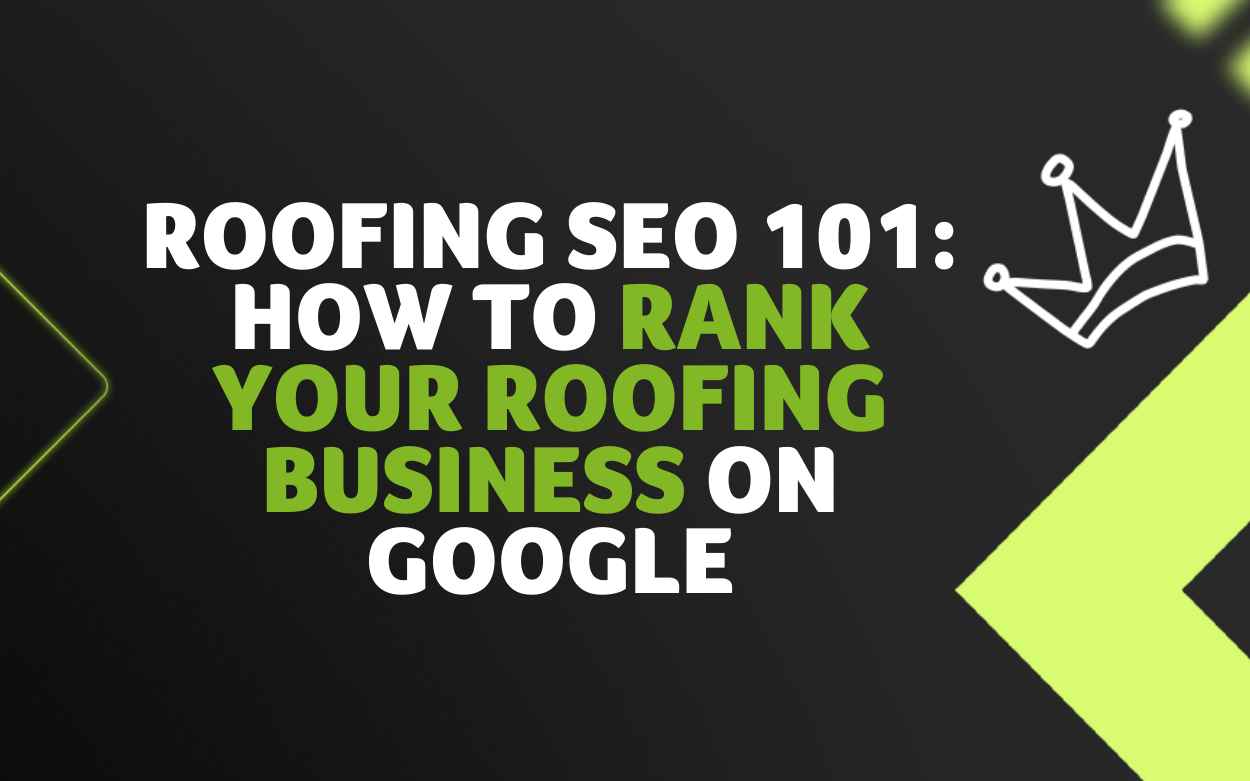
 Like many trades, roofing companies often rely on word-of-mouth referrals to bring in new business. But what happens when you want to expand your customer base beyond referrals?
Like many trades, roofing companies often rely on word-of-mouth referrals to bring in new business. But what happens when you want to expand your customer base beyond referrals?
Growing a roofing business can be challenging, especially with so many companies competing for attention. Most people needing a roofer will turn to someone they trust for a recommendation.
When that’s not an option, they’ll likely turn to a search engine to look for roofing websites. That’s where SEO (Search Engine Optimization) comes in.
This article provides essential SEO strategies that help roofers stand out online, attract new leads, and grow their business.
What is SEO for a Roofing Company?
SEO, or search engine optimization, are techniques and processes that help websites appear higher in search engine results. SEO means adjusting your site so that when people search for roofing services, your website is more likely to appear at the top of organic search results:
Source: Google
Search engines like Google decide which sites to show first by analyzing a whole range of factors, including:
➡️Relevance to the search term
➡️Website quality
➡️Authority (i.e., how many trusted sites link back to yours – more on this below!).
This means that the more useful and relevant your site is to a potential client searching for a “roofer near me” or “roof repair,” the higher it’s likely to rank.
Ranking high is essential because people trust Google’s top recommendations—most searchers won’t scroll past the top three results. By optimizing your website for SEO, you’re increasing the chances that potential customers will see and click on your business when they’re looking for roofing services.
Is Roofer SEO Worth It?
SEO can be incredibly valuable for roofers. It’s a long-term strategy that boosts your website’s visibility and brings in a steady stream of potential clients. Let’s take a look at the potential ROI using the example of a high-value keyword: “roofer in San Diego:”

This keyword has a search volume of around 200 searches per month. If your website ranks first, you can expect about a third of those visitors to click on your site—around 66 people a month or 792 over the year.
Assuming a 2% conversion rate would mean roughly 15 inquiries annually. With a typical roof replacement costing about $21,054, those 15 inquiries could bring in approximately $315,810 in revenue annually.
Keep in mind this is for just one keyword. SEO can work on multiple keywords, steadily building inquiries for each service you offer.
Additionally, SEO benefits extend beyond immediate lead generation.
Ranking for multiple roofing-related search terms helps establish your brand as a trusted, knowledgeable source in the roofing industry.
Even if some visitors aren’t ready to hire a roofer immediately, seeing your business repeatedly in their searches and providing helpful information builds familiarity and trust.
When they’re ready to commit, they’re more likely to remember and choose a brand they’ve seen consistently.
SEO offers excellent returns over time for roofers looking to attract steady business without relying solely on Google ads.
| 💡Key point: What’s the difference between PPC and SEO? PPC (Pay-Per-Click) and SEO (Search Engine Optimization) are both tools for reaching customers but serve different purposes. PPC or Pay-Per-Click advertising, is a digital marketing model where advertisers pay a fee each time someone clicks on their ad. PPC helps you reach people ready to hire a roofer immediately by putting your business at the top of search results—perfect for urgent searches like “emergency roof repair.” However, it requires a recurring ad budget. Conversely, SEO takes time to build but captures people at all stages of their search, from learning about roofing materials to finding a local roofer. While PPC delivers fast results, SEO provides lasting visibility, and a mix of both gives you the best of both worlds. |
Step-by-Step Guide to SEO for Roofing Companies
1. Show E-E-A-T
Establishing Experience, Expertise, Authoritativeness, and Trustworthiness (E-E-A-T) is essential for your roofing company’s online presence.
E-E-A-T is a framework used by Google to evaluate the quality and reliability of web pages, which can significantly impact your search rankings. It stands for:
- Experience: Demonstrating firsthand knowledge of roofing services.
- Expertise: Showcasing specialized skills and qualifications in the roofing industry.
- Authoritativeness: Being recognized as a leading source of roofing information.
- Trustworthiness: Building confidence through transparency and reliability.
Ways to enhance E-E-A-T
➡️Display customer reviews: Feature testimonials from satisfied clients to highlight your experience and build trust.
➡️Highlight professional accreditations: Showcase certifications and memberships in reputable industry organizations to establish expertise and authority.
➡️Introduce your team: Provide profiles of your team members, including their qualifications and experience, to demonstrate expertise and personalize your brand.
➡️Create quality content: Publish informative guides and articles on roofing to showcase your knowledge.
➡️Ensure transparency: Display your contact information, business address, and service areas clearly to build trust with your audience.
Example of E-E-A-T in action
Deer Park Roofing is a strong example of E-E-A-T, with:
✅Customer reviews and testimonials:
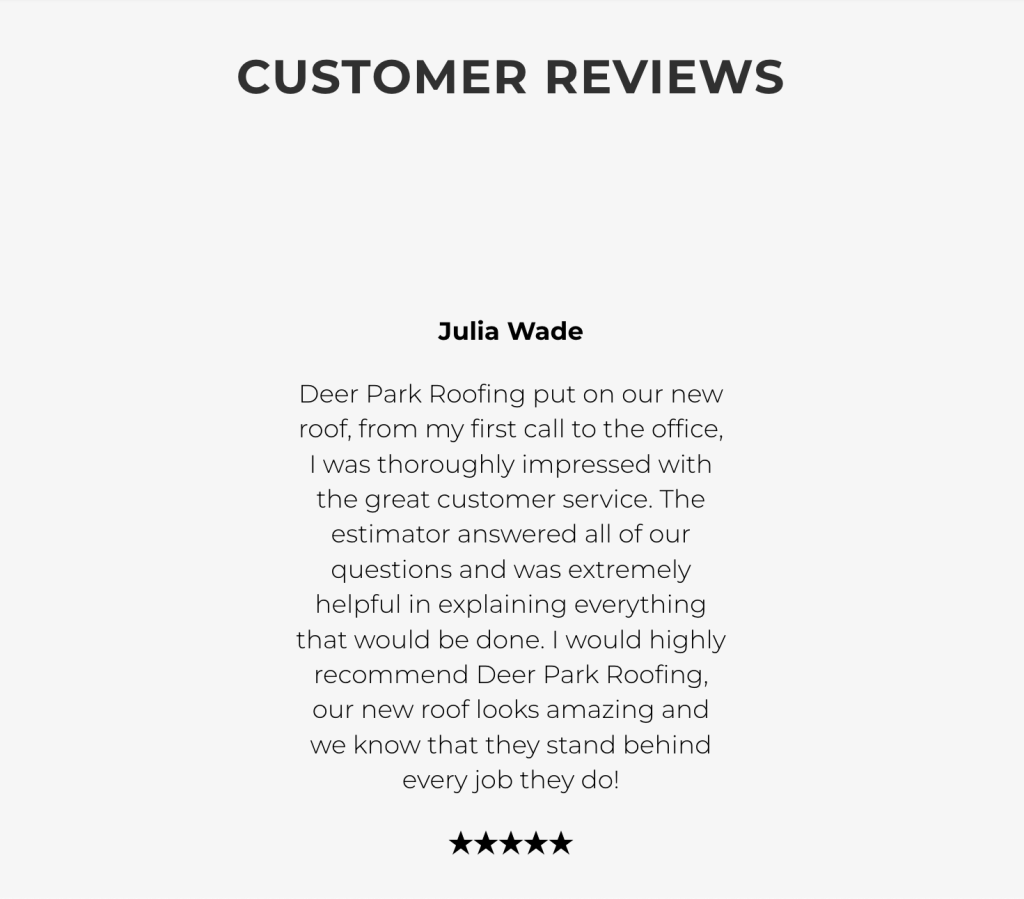
✅Professional accreditations and certifications:

✅Team introductions with detailed profiles:

✅Informative content about roofing services:

Set up location pages for your roofing website.
Creating dedicated local pages is essential for helping potential customers find your roofing services in specific areas. By setting up a page for each city or neighborhood you serve, you improve your chances of appearing in local search results, which increases your visibility among nearby clients.
For example, if you serve multiple locations, you could create separate pages like “Roof Repair in [City]” or “Roof Replacement Services in [Neighborhood].”

Source: Brothers Services
In addition to local pages, consider adding dedicated service pages. Each core service you offer—such as roof inspections, repairs, and replacements—should have its own page.
This allows you to target specific keywords and provide detailed information about each service, which enhances SEO and helps potential clients find exactly what they need.
2. Sign up for local citations
Most roofing companies focus on serving specific local areas rather than reaching a national or global market.
To help potential customers find you, establish a presence on industry-specific directories like Angi (formerly Angie’s List), HomeAdvisor, and Houzz. These directories, also known as local citations, serve as online references for your local business and contribute to your online visibility.

Source: Angi
Local citations make it easier for people to find your roofing business and enhance your SEO efforts. They signal search engines, confirming your business’s legitimacy, location, and relevance within your community.
Google Business Profile
When it comes to roofing SEO, one of the most important citations to prioritize is your Google Business Profile. A strong Google Business Profile boosts your local SEO, helping you appear in local searches. You may even secure a spot in the coveted “Local Pack” at the top of search results.
What is the Local Pack?
The Local Pack is a prime spot in search results when someone is looking for a local service.
For example, if a potential customer in Chicago searches “roof repair in Chicago,” the Google Local Pack shows a select group of roofing companies, along with their reviews and locations on Google Maps:
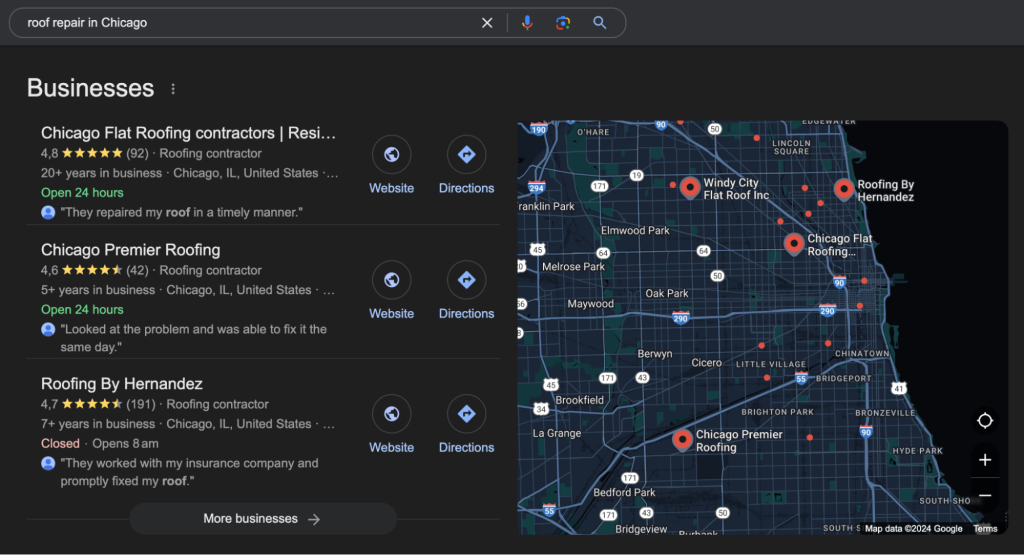
Source: Google
Securing a spot at the top of local search rankings isn’t about luck—it’s about optimizing your Google Business listing, generating reviews and maintaining consistent citations across various local directories. Below, we’ll show you how to set it up:
How to set up your Google Business Profile for your roofing business
1️⃣ Create or sign in to your Google Account
2️⃣ Go to Google Business Profile
3️⃣ Add or claim your business: If your roofing business is already listed, you can claim it and verify ownership. If it’s not listed, click on “Add your business” or “Manage now” to start the process.
4️⃣ Provide accurate and complete information:
- Business name
- Address
- Phone number
- Website URL
- Business category (e.g., “Roofing Contractor,” “Roof Repair Service”)
- Service areas (the neighborhoods or cities you serve)
- Business hours
5️⃣ Verify your business: Google will send a postcard with a verification code to your business address. Enter the code on your Google Business dashboard to complete verification.
| 💡Pro Tip: Depending on your account, alternative verification methods may be available. Check your Google Business dashboard for options. |
6️⃣ Optimize your listing: Once verified, go the extra mile to make your profile stand out. Add relevant details, such as:
- A business description that highlights your roofing specialties and unique selling points.
- High-quality photos of completed roofing projects and your team.
- Engaging posts about seasonal roofing tips, local events, or promotions.
- Client reviews, which build trust and demonstrate your expertise.
Do keyword research
Keywords are the words and phrases people type into search engines when looking for something specific. For roofing contractors, these might be things like:
- Roofing services near me
- Roofing companies in [City/State]
- Roof installation services
- Roof repair contractors
Relevant keywords are crucial because they help connect your roofing company with those searching for your services. Below, we’ll show you how to identify keywords with Ahrefs.
1️⃣ Brainstorm seed keywords
Start by thinking about your core roofing services and materials. What are the main terms people use to search for roofing services? These are your “seed keywords.”
For example, if you specialize in residential roof repair, your seed keywords might be “roof repair,” “residential roof repair,” or “leaky roof repair.” If you offer specific materials, consider keywords like “asphalt shingle roof,” “metal roofing,” or “flat roof installation.”
Head over to Ahrefs’ Keywords Explorer tool. In the search bar, enter one of your seed keywords (e.g., “residential roof repair”). Choose your target country and hit search:
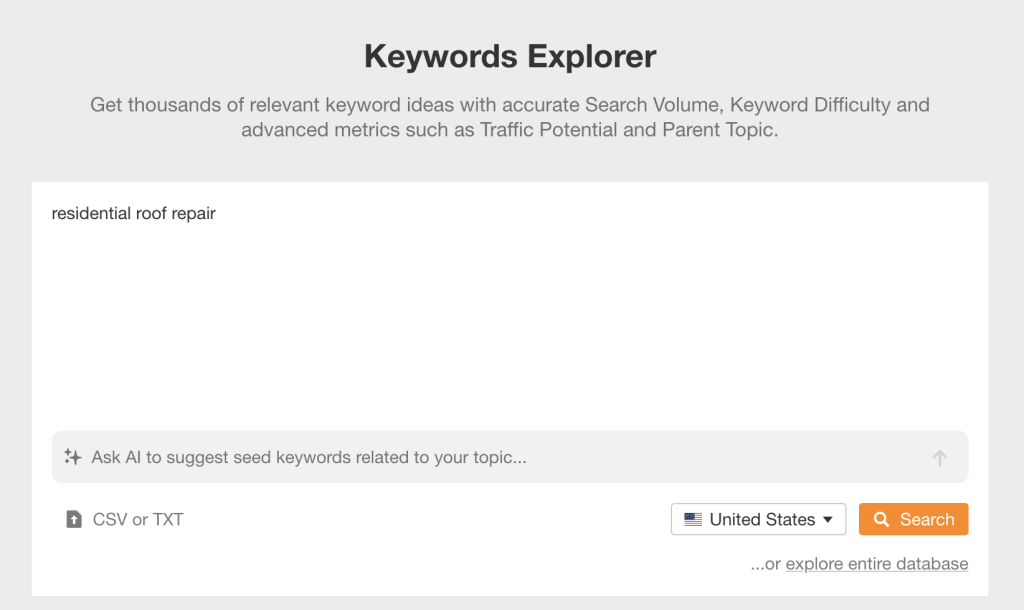
Source: Ahrefs
2️⃣ Explore keyword ideas
Ahrefs will generate a ton of keyword ideas related to your primary keyword. You’ll see metrics like:
- Search volume (how many people are searching for that keyword).
- Keyword difficulty (how hard it is to rank for that keyword).
- Traffic potential (how much traffic you could get if you ranked #1 for that keyword).
For example, our keyword “residential roof repair” has a search volume of 1,900, with a traffic potential of 18,000. It also has a keyword difficulty of 60, which means it’s hard to rank organically:

Source: Ahrefs
| 💡Key Point: Think Local
While broad roofing keywords like “residential roof” are highly competitive, don’t overlook the power of localized search. Targeting location-specific keywords (e.g., ” roof repair Dallas”) can help you reach a more relevant audience and improve your chances of ranking well in your local search results. For example, in the screenshot below, you can see that ” roof repair Dallas” has a KD of 9, a search volume of 600 per month, and a traffic potential of 2,200—ideal for roofing companies in Dallas!
Source: Ahrefs |
3️⃣ Uncover long-tail keywords
Long-tail keywords are longer, more specific phrases that people use in their searches. They often have lower search volume but higher conversion rates because they target a more specific audience.
Explore the different reports within Keywords Explorer to identify keywords:
- Terms match: Shows you keywords that closely match your seed keyword.
- Also rank for: Shows you broader keywords that are related to your topic.
- Questions: Reveals questions people are asking related to your keyword, which can be great for blog post ideas.

Source: Ahrefs
4️⃣ Analyze the SERPs
Next, do a competitor analysis by reviewing the top-ranking pages for your keyword. This gives you valuable insights into what kind of content is performing well and what you need to do to compete:

Source: Ahrefs
5️⃣ Download keywords
Once you have selected a keyword in Ahrefs, you can export the list of matching terms. Under “keyword ideas,” click on “view all.”
This will take you to a detailed page with all related keywords. On the left-hand side, click “Export,” and choose to download the data in CSV format:

Source: Ahrefs
| 💡Pro-tip: Don’t have access to keyword research tools?
Don’t worry! To look for target keywords, you can use Google Keyword Planner. It’s a free tool that can help you with keyword research. |
On-page SEO
On-page optimization is another key aspect of your roofing SEO strategy. It involves enhancing your roofing website so that search engines can easily understand, navigate, and index it. These improvements help your site rank better and create a more user-friendly experience.
Here’s a checklist of key on-page elements to optimize:
Title Tags
These are the clickable headlines that appear in search engine results. They tell both search engines and users what each page is about. Here is an example of a title tag:

Source: Google
Meta descriptions
Meta descriptions are short summaries that appear under the title tag in search results. They give users a snapshot of your page and encourage them to click. For example:

Source: Google
Headings (H1, H2, etc.)
These structure your web content, making it easy to read. H1 is the main title, while H2s and H3s are subheadings that organize the information in a logical way. Here’s an example from a blog post
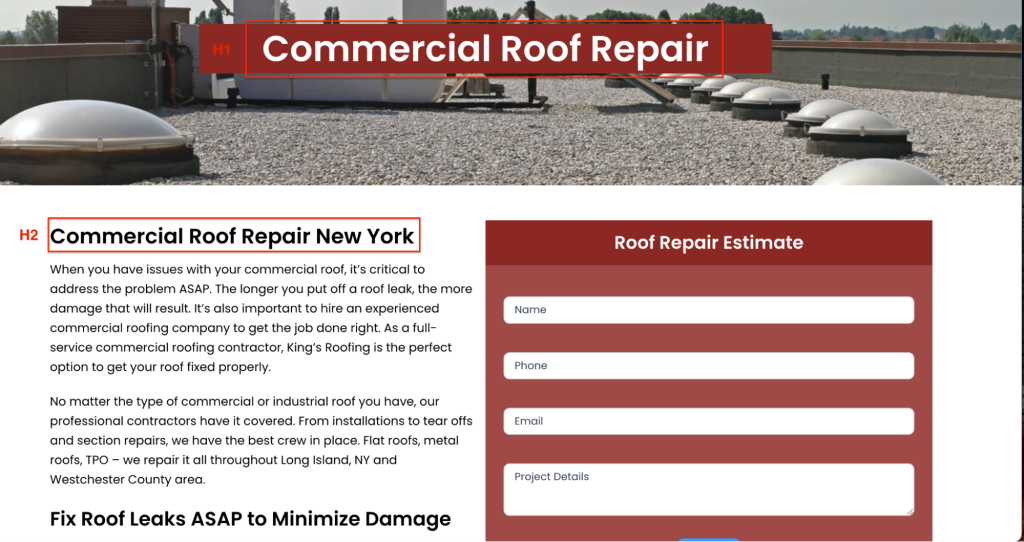
Source: King’s Roofing NY
Image alt text
Alt-text descriptions are added to images to improve SEO and accessibility, helping search engines understand what each image represents.
For example, an image of a newly installed asphalt shingle roof could have alt text like: “New asphalt shingle roof installed by [Your Company Name] in [City].”
Internal links
Link to other relevant pages on your site to help users explore your content. For example, on a page about roof repair, link to other services like “Roof Replacement” or “Roof Inspection Services.”
Keyword usage
Use target keywords throughout your content naturally. Avoid overloading the page with keywords, as this can negatively impact your SEO.
| 💡Key point: What is Keyword Stuffing?
Keyword stuffing is when keywords are used repeatedly in a way that feels unnatural, with the goal of tricking search engines into ranking the page higher. This tactic can backfire, hurting your SEO and making content harder to read. |
Create quality content
Creating high-quality content is one of the most effective ways to improve your SEO and set your roofing business apart from competitors.
While many roofing companies may not invest heavily in content, doing so gives you a unique advantage, helping you attract search traffic and build authority in the industry.
Why does content matter for search engine optimization?
Search engines like Google prioritize websites that offer users valuable, informative, and relevant content.
Regularly updating your site with fresh content allows you to rank for a wider range of keywords, targeting new search queries and reaching a broader audience. Newer content is also more likely to be ranked by search engines, which value timely, up-to-date information that matches current user needs.
Creating content that answers people’s questions and addresses their needs will attract more organic traffic to your website. This will increase your visibility and establish your company as a trusted authority in the roofing industry.
Think about it: when someone has a question about their roof, what do they do? They turn to the internet. If your website provides clear, concise, and helpful answers to their queries, they’re more likely to trust your company and ultimately choose you for their roofing needs.
A great example of this is B&C Heemar Roofing’s blog post addressing concerns about lead in roofing. By directly addressing a common concern, they position themselves as knowledgeable professionals and build trust with potential customers.
Beyond answering questions, various other content formats can boost your SEO:
✅DIY guides
Provide your audience with practical knowledge on how to do something. Open Box Roofing’s guide on roof flashing repair is a great example:
Source: OpenBox
This type of content attracts homeowners who prefer to tackle minor repairs themselves, showcasing your expertise even if they don’t hire you for that specific job.
✅Video guides
Visual content is highly engaging. Research has shown that 91% of people have watched an explainer video to learn more about a product. Consider creating videos that demonstrate roofing techniques, explain different roofing materials, or offer virtual tours of completed projects.
Here is a great example of creating high-quality video guides. The Willamette Chimney YouTube channel provides expert guidance on cleaning and maintaining chimneys:
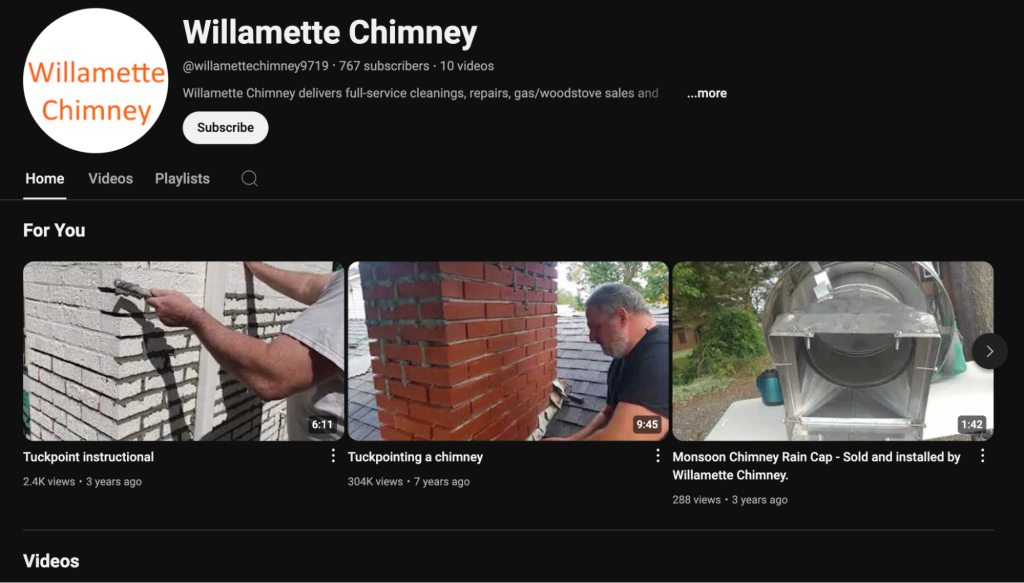
Source: YouTube
✅Useful diagrams and infographics
Complex information can be easily digested with visual aids. CD Roofing Ltd. effectively uses diagrams to illustrate the anatomy of a roof:

Source: CD Roofing Ltd
This approach simplifies technical details and makes your website more user-friendly.
Build links
Building links, or getting other websites to link back to yours, is essential in SEO. Google sees links as “votes of confidence,” where each link from another website to yours signals trust and relevance.
The more quality inbound links you have, the more likely Google sees your website as a valuable resource, which can help improve your ranking. Let’s take the keyword we used earlier: “residential roof repair.” The top articles all have a number of backlinks:

Source: Ahrefs
However, not all backlinks are equal. Some can boost your credibility, while others might harm it.
Here’s a quick look at good vs. bad backlinks:
| Good backlinks | Bad backlinks |
| Links from trusted, relevant websites | Links from low-quality, spammy sites |
| Earned naturally (e.g., through valuable content) | Purchased or artificially created |
| Contextually relevant to roofing or construction | Irrelevant or unrelated industries |
Let’s explore a few ways you can build high-quality links:
Blogger outreach
Blogger outreach involves contacting bloggers or websites in the home improvement or construction niche and encouraging them to link to your content by creating a new post or updating an existing one.
The aim is to introduce your content as a valuable resource for their audience, often by providing fresh, unique content (such as a new guest post or expert quote) that includes a link back to your site.
Finding the right bloggers can be challenging. Look for those with a good reputation in home improvement or the roofing industry. Personalize each outreach message to explain why your content would benefit their readers.
For example, say you have a detailed guide on roofing materials. This could be a valuable addition to a blog post about the signs that it’s time to replace your roof, earning you a backlink.
Here’s an example of an outreach email you could send to the blog:
Subject: Helpful Roofing Guide for Your Readers
Hi [Blogger’s Name],
I’m [Your Name] from [Roofing Company]. I noticed you’ve written about the signs it’s time to look for a roof replacement. We recently created a detailed guide on roofing materials that could be valuable for your readers. Let me know if you’d like to check it out!
| 📢 Pro Tip: Focus on Adding Value
When reaching out for backlinks, make sure your content genuinely benefits the website and its readers. Rather than asking out of the blue, take time to build a relationship first. Engage with their social media posts, leave thoughtful comments on their blogs, and show interest in their work. Establishing a genuine connection increases your chances of gaining their trust and, ultimately, a backlink. Remember: Building backlinks is about relationship-building, not just link-building. |
Niche edits
Niche edits involve finding relevant, existing content and asking to add a link to your roofing article within it.
Instead of creating new material, niche edits let you place your link in established content that already ranks and attracts traffic. This is particularly useful if the article aligns with roofing and home improvement topics.
Since niche edits work with existing, high-traffic posts, your backlink benefits from the page’s existing authority. It’s often quicker to see referral traffic, and SEO gains this way, especially if the content is well-trafficked and already trusted by Google.
Broken link building
Broken link building is a smart strategy to gain backlinks by identifying broken links on other websites (links that lead to a “404 Page Not Found” error) and offering your roofing-related content as a replacement. This approach creates a win-win scenario:
✔️ For the website owner: They improve user experience by fixing broken links.
✔️ For you: You gain a valuable backlink from a relevant, authoritative source, helping your roofing SEO and increasing site traffic.
Here’s how to use Ahrefs for broken link building:
Start by finding websites related to roofing, home improvement, or real estate that have strong authority. These could include local home improvement blogs, construction industry sites, or real estate resources.
For the purposes of this article, we’ll use Apartment Therapy – a popular website focused on home design, decor, and lifestyle. Next, enter its domain into Ahrefs’ “Site Explorer” tool:

Source: Ahrefs
Navigate to the “Outgoing links” section, then choose “Broken links.” This will reveal a list of broken outbound links on the site:

Source: Ahrefs
Review the broken links list to identify links that match your roofing content. For example, if a link to an article on “Signs You Need a New Roof ” is broken, you could suggest your guide on that topic as a replacement.
If you already have content aligning with the broken link, ensure it’s high-quality and relevant. If you don’t, consider creating a new article that meets the needs of that topic.
| 💡 Pro Tip: Use Ahrefs’ “Content Explorer” to find broken pages based on roofing-specific keywords. Enter terms like “roof replacement” or “roof repair,” filter for broken pages, and sort by referring domains to find pages with existing backlinks. |
Digital PR backlinks
PR backlinks are a way to earn backlinks through press releases, media coverage, or interviews.
Digital PR can be particularly effective for roofers, especially given current trends in sustainable and energy-efficient roofing solutions. By providing expert insights, you can attract links from reputable industry publications.
For example, this article quotes a roofing company executive, showcasing their expertise. This type of exposure boosts credibility, helping Google see your site as an authority in the roofing field:

Source: PV Magazine
Become a source
You’re probably wondering how to do this. The easiest way to obtain PR backlinks is to become a source via Connectively (formerly HARO)
By signing up for Connectively, roofing companies can respond to industry-specific queries, offering quotes or expert opinions on roofing materials, maintenance, or trends in sustainable roofing.
When your insights are featured in an article (like the one above), the publication often includes a backlink to your website, helping you gain visibility and boost SEO.
For example, if your niche is roofing, a query might ask for an expert opinion on “the benefits of energy-efficient roofing materials” or “how to identify signs of roof damage.” This is your opportunity to share your expertise and build authority within the industry.
Here’s how to use Connectively for Backlinks:
- Sign up for a free account on Connectively as a source.
- You can set preferences for the types of queries you’d like to receive, such as topics related to tech, startups, or your specific niche.
- Review daily emails with media queries from journalists and bloggers.
- Respond to relevant queries by clicking “pitch,” providing your insights, credentials, and website link.
| 🔗 Building Quality Backlinks Made Easy
Effective link-building can be tough and time-consuming, but you don’t have to do it alone. Let Authority Builders handle the hard work, delivering high-quality backlinks that boost your website’s authority and help you rank higher. Get started today and see the difference professional link-building can make! |
Technical SEO
Technical SEO focuses on optimizing your website’s behind-the-scenes elements, making it easier for search engines to understand, and rank your pages. While content and backlinks are crucial, technical SEO ensures that your roofing site functions smoothly and is accessible to search engines and potential clients searching for roofing services.
Technical SEO covers a range of factors, but here are the most important ones for roofing companies:
Site speed
A fast-loading website is essential. Compress images, optimize code, and choose a reliable hosting provider to ensure your site loads quickly for a seamless user experience.
➡️ Use Google’s PageSpeed Insights to check your site speed and get recommendations for improvement.
Mobile-friendliness
Most people search for roofers on their phones, especially when they need fast information. Ensure your site has a responsive design, looks and functions well on all devices, and provides a positive experience for mobile users.
➡️ Google Lighthouse can help you assess your site’s mobile-friendliness.
Security (HTTPS)
Security is vital for building trust with customers. Make sure your website uses HTTPS to protect user data and signal to search engines that your site is safe and reliable.
➡️Check out this guide on implementing HTTPS encryption to secure your website.
Monitor results
Tracking SEO metrics is essential to understanding where your roofing SEO campaigns are succeeding and where there’s room for improvement. By monitoring key metrics across different customer journey stages, you’ll gain insights into how well your SEO efforts are working and where to adjust.
Here are some important metrics to watch:
➡️Organic rankings: Track where your site ranks for important keywords. Improving your rankings can lead to higher visibility and more traffic.
➡️Organic traffic: Measure the number of visitors coming to your site from search engines. Growth in organic traffic indicates that your SEO efforts are drawing in more potential customers.
➡️Time on page/ dwell time: This metric shows how long visitors stay on your pages, indicating whether your content is engaging and relevant. High dwell time suggests users find your content valuable.
➡️New leads: Track the number of leads generated from organic traffic, such as contact form submissions or calls. This is the ultimate measure of how well SEO converts visitors into potential customers.
Tools to use:
📈Google Search Console (GSC): Monitor your site’s keyword rankings, click-through rates, and search visibility.
📈Google Analytics: Track organic traffic, user behavior, and conversion rates to understand how visitors interact with your site.
📈Ahrefs: Analyze keyword rankings, backlinks, and competitors to refine your SEO strategy and stay ahead.
How to Manage Roofing SEO
When it comes to SEO, roofers have four main options, each with its pros and cons. Choosing the right approach depends on your budget, goals, and the level of expertise you want to bring to your SEO efforts. Here’s a breakdown:
Do It Themselves
✅Pros: Cost-effective; direct control over strategy.
❌Cons: SEO has a steep learning curve, and roofers often lack the time to fully manage it, potentially leading to slow results.
Hire an Employee
✅Pros: Dedicated in-house support; the employee can become familiar with your business.
❌Cons: Hiring and training can be expensive, and you may still need to invest in SEO tools. An in-house hire may also lack specialized SEO knowledge, especially for a competitive field like roofing.
Hire a Freelancer
✅Pros: Generally more affordable than an agency; flexibility to work on specific projects.
❌Cons: Freelancers may lack an agency’s resources, and availability can be inconsistent. Quality and depth of SEO expertise can also vary.
Hire roofing SEO services
✅Pros: A Roofing SEO company brings specialized, experienced teams with access to advanced tools and strategies. They stay up-to-date with SEO changes, giving you a comprehensive approach.
❌Cons: Typically higher cost, but often provides the best return on investment for competitive SEO fields like roofing.
In short, while DIY or hiring freelancers can work to handle basic SEO tasks, partnering with professional roofing SEO services is often the most effective choice. An SEO company provides the expertise and dedicated focus needed to grow your online presence, attract leads, and, ultimately, drive more business.
Need Help with Your Roofing SEO Strategy?
Authority Builders specializes in helping roofing companies like yours thrive online. Our services include:
Ready to increase your online visibility and help more people find their path to recovery? Sign up today!

